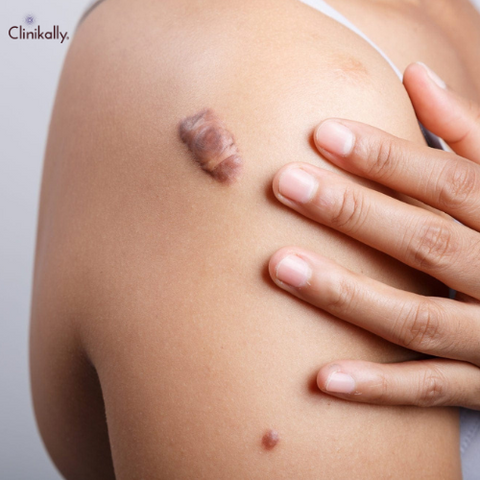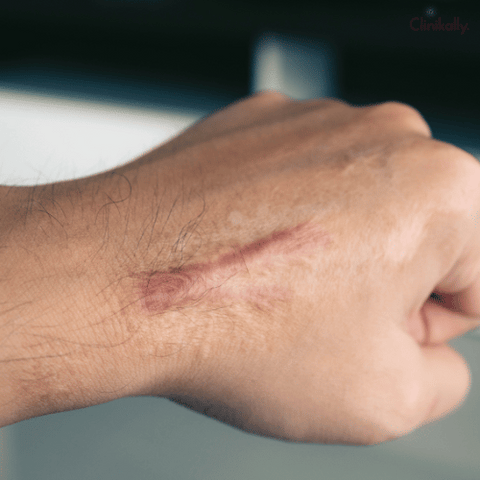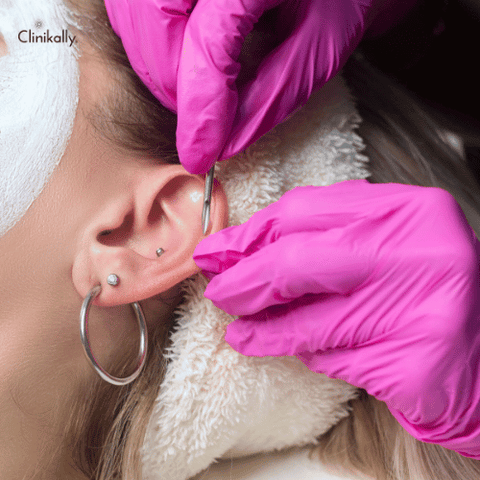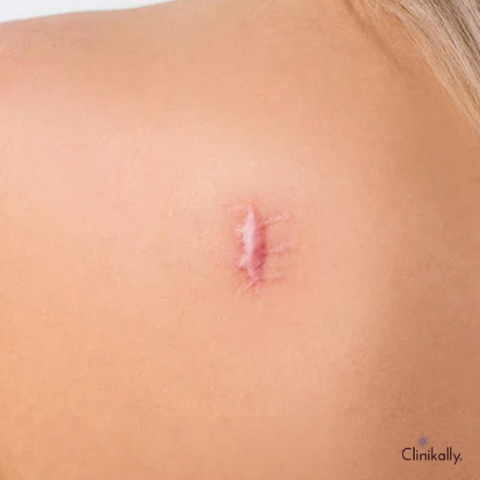Raised, thicker skin patches that occur after surgery or injury are known as "hypertrophic scars." These scars often emerge at the site of the initial wound and are distinguished by their raised appearance and reddish-pink colour. We will examine the genesis, traits, and treatment of hypertrophic scars in this response. Hypertrophic Scar Formation Overproduction of collagen occurs throughout the healing process, which leads to the development of hypertrophic scars. The connective tissue in our skin is made up of the protein collagen, which gives our skin its strength and suppleness. During the healing process, a hypertrophic scar may develop if the body creates too much collagen.
Scars with hypertrophic characteristics are elevated and thickened, and they may be uncomfortable or itchy. Additionally, they can restrict motion in the affected area, especially if the scar is close to a joint. Reddish-pink hypertrophic scars are common, and people with darker skin tones may detect them more readily. The optimum course of treatment for a hypertrophic scar should be decided in collaboration with a healthcare professional because it may differ depending on the size, location, and severity of the scar.
Understanding Hypertrophic Scars

Hypertrophic scars, which are raised, thicker, and discoloured, form as a result of abnormal wound healing. They can appear anywhere on the body and are more common in younger and darker-skinned people. Keloid scars, which extend over the borders of the initial incision and have the potential to enlarge over time, differ from hypertrophic scars. Hypertrophic scars can be uncomfortable and painful, restrict movement, and lower a person's self-esteem. Although they frequently get better with time, they might never go away entirely without treatment. Genetics, the depth of the incision, and the location of the wound are a few of the elements that affect how hypertrophic scars develop.
Formation and Characteristics
When there is an excessive amount of collagen produced during the healing process, hypertrophic scars develop. The protein collagen aids in giving the skin strength and structure, but when it is produced in excess, it can result in the development of a raised, thickened scar. After an injury or surgery, hypertrophic scars normally appear a few weeks later and are commonly coloured red, pink, or purple. They may hurt or itch, and if they develop in places where there is a lot of movement, like over a joint, they can be uncomfortable or restrict mobility. Hypertrophic scars are usually limited to the site of the original wound and do not extend beyond the injury's boundaries. They may become less noticeable over time, but without treatment, they may never completely disappear.
Differentiating from Other Scar Types
Hypertrophic scars are frequently confused with keloid scars, but there are some distinctions between the two.
Hypertrophic scars:
-
Maintain the original wound or incision's boundaries.
-
Are raised and thickened, but do not usually extend beyond the wound site
-
The colour can be pink, red, or purple.
-
Typically appear within weeks of an injury or surgery.
-
Without treatment, it may become less noticeable over time, but it may never completely disappear.
Keloid scars:
-
Extend beyond the original wound or incision's boundaries
-
Can continue to expand in size over time
-
Are typically darker than the surrounding skin.
-
Itching or pain may occur.
-
Can appear months, if not years, after an injury or surgery.
Although hypertrophic scars and keloid scars may resemble one another, they are different in their causes and may require different treatments.
Causes and Risk Factors

Any type of skin trauma or injury, including surgical incisions, burns, cuts, and even acne, can result in hypertrophic scarring. However, some people are more likely than others to develop hypertrophic scars. The following are some typical risk factors for hypertrophic scarring:
-
Genetics: Some people are genetically predisposed to developing hypertrophic scars.
-
Age: Children and young adults are more prone to hypertrophic scarring.
-
Darker skin tones: Hypertrophic scarring is more common in people with darker skin tones.
-
Injury site: Areas of the chest and shoulders that experience a lot of tension or movement are more likely to develop hypertrophic scarring.
-
Inflammation or infection: Inflammation or infection at the site of the wound can raise the possibility of developing hypertrophic scars.
-
Poor wound healing: People who have weak wound healing as a result of underlying health issues like diabetes or poor circulation may be more prone to getting hypertrophic scars.
It's important to remember that anyone can get hypertrophic scars after an injury or surgery, even though some people might be more prone to it than others.
Skin Injuries and Wound Healing
The body naturally begins the wound-healing process when the skin is injured. The complicated process of wound healing entails a number of steps, such as:
-
Hemostasis: The process of creating a blood clot to stop bleeding is the first step in wound healing.
-
Inflammation: The next stage involves an inflammatory response in which immune cells are recruited to the wound site to aid in infection control and debris removal.
-
Proliferation: At this stage, new cells form and begin to rebuild the damaged tissue.
-
Remodelling: The final stage entails reorganising the new tissue, which can take several months.
To ensure proper wound healing, there must be an adequate blood supply to the wound site, as well as the presence of certain growth factors and proteins that aid in healing.
Certain factors, however, can impede wound healing, including:
-
Diabetes and autoimmune diseases are examples of chronic health conditions.
-
Corticosteroids and chemotherapy drugs are examples of medications.
-
Poor nutrition can result in nutrient deficiencies, which can impair wound healing.
-
Tobacco use, which can reduce blood flow and oxygen delivery to the wound site.
-
Infection, which can stifle or disrupt the healing process.
Making sure you get enough nutrition, refraining from smoking, keeping the wound clean and protected, and taking action are all important ways to promote healthy wound healing. Medical intervention, such as the use of drugs or surgical procedures, may occasionally be required to aid with wound healing.
Factors Affecting Collagen Production
The development and upkeep of skin, bones, muscles, tendons, and other connective tissues depend heavily on the protein collagen. There are numerous factors that can have an impact on collagen production, such as:
-
Age: The production of collagen naturally decreases with advancing years, which can result in skin wrinkles, joint pain, and other age-related conditions.
-
UV radiation: Prolonged sun exposure damages collagen fibres and hastens the ageing process.
-
Nutrition: The body needs specific nutrients, like vitamin C, in order to produce collagen, so proper nutrition is crucial for collagen production.
-
Hormones: Hormones, such as oestrogen, which stimulates collagen production in the skin, can affect collagen production.
-
Chronic inflammation: Prolonged inflammation has the potential to harm collagen fibres and reduce collagen synthesis.
-
Genetics: Specific genetic factors can have an impact on both the structure and production of collagen.
-
Lifestyle factors: Smoking, for example, can reduce collagen production and hasten the ageing process.
Following healthy lifestyle habits, eating a balanced diet, and protecting the skin from UV rays are essential steps to take in order to increase collagen formation. Supplements containing collagen can occasionally be used to encourage the production of collagen and support the health of the skin, bones, and other connective tissues.
Hypertrophic Scar Treatment Options

There are several treatment options for hypertrophic scars, including:
-
Corticosteroid injections: Corticosteroids are medications that are injected directly into scar tissue to reduce inflammation and promote collagen breakdown. This can assist in flattening and softening the scar.
-
Silicone gel or sheets: Silicone gel or sheets can be applied to the scar to help reduce redness, itching, and discomfort. They can also help the scar to flatten and soften over time.
-
Pressure therapy: Applying pressure to the scar with a specialised dressing or device to help flatten and soften the scar tissue is referred to as pressure therapy.
-
Laser therapy: Laser therapy can be used to reduce scar tissue redness and thickness. This entails using a laser to break down scar tissue and stimulate collagen production.
-
Surgical revision: In some cases, surgical revision may be required to remove scar tissue and produce a more cosmetically appealing outcome.
The ideal treatment strategy for your particular circumstance should be determined in collaboration with a healthcare professional or dermatologist. They can assist you in creating a customised treatment plan to help you get the best results by assisting you in weighing the advantages and disadvantages of each treatment option.
Silicone Gel Sheets and Steroid Injections
Two popular methods of treating hypertrophic scars include silicone gel sheets and steroid injections.
-
A non-invasive therapeutic alternative that can be put directly on the scar is silicone gel sheets. They function by offering a moist atmosphere that aids in softening and flattening the scar tissue. The scar's related redness and itching may also be lessened with the aid of the sheets. Although the recommended usage period can change, they are typically worn for several hours per day for a few weeks or months.
-
A less invasive therapy method called steroid injections involves injecting corticosteroids right into the hypertrophic scar. This may aid in reducing swelling and promoting collagen deterioration, resulting in a flatter, softer scar. Depending on the specific circumstances, steroid injections may be repeated every few weeks or months. It's vital to remember that steroid injections should only be given by a medical practitioner as they can have some negative effects, such as skin thinning or discoloration.
The effectiveness of silicone gel sheets and steroid injections in treating hypertrophic scars has been demonstrated, however, the optimal course of action for a particular patient will depend on the extent and location of the scar, as well as their own health and medical background. It's crucial to speak with a dermatologist or healthcare professional to figure out the best course of action for your particular situation.
Laser Therapy and Cryotherapy
Two additional treatments for hypertrophic scars include laser therapy and cryotherapy.
-
The top layer of skin is removed with a high-energy light beam in laser therapy, which can help minimise the size and visual impact of hypertrophic scars. Scars can be treated with a variety of lasers, including pulsed dye lasers, fractional lasers, and carbon dioxide lasers.
-
On the other hand, cryotherapy uses extremely freezing temperatures to freeze and kill the skin's top layer of cells, which can promote the creation of new skin and lessen the visibility of scars. For cryotherapy, liquid nitrogen is frequently used.
Also, cryotherapy and laser therapy may need several sessions to provide the desired outcomes, and they also carry the risk of unpleasant side effects like redness, swelling, and scarring. It's crucial to go over the advantages and disadvantages of these treatments with a licensed healthcare provider.
Prevention and Skin Care Tips
Although it can be difficult to stop hypertrophic scars from forming in the first place, there are some steps that can be taken to lower the risk of doing so. These consist of:
-
Proper wound care: Proper wound care is essential for avoiding hypertrophic scars. To avoid infection and encourage healing, the wound must be kept clean, moist, and covered.
-
Avoiding tension at the wound site: Stress at the wound site can increase the production of collagen, which results in hypertrophic scarring. It is possible to prevent tension on the wound site by keeping the area immobile or by wearing pressure clothing.
-
Sun protection: Sun exposure can cause hyperpigmentation and delay wound healing, increasing the risk of hypertrophic scarring. Keeping the wound site covered or using a broad-spectrum sunscreen can help protect it from the sun's harmful UV rays.
-
Maintaining a healthy lifestyle: Eating a vitamin and mineral-rich diet, getting enough sleep, and not smoking can help improve overall skin health and promote wound healing.
-
Seeking treatment as soon as possible: Seeking treatment for wounds as soon as possible can help prevent them from developing into hypertrophic scars. This can include seeking medical attention for deep or severe wounds and adhering to proper wound care instructions.
If you do develop a hypertrophic scar, the following skincare tips can help you manage its appearance:
-
Massaging the scar: By increasing blood flow and breaking up scar tissue, massaging the scar on a regular basis can help reduce its size and improve its appearance.
-
Using silicone gel sheets: By hydrating the skin and creating a barrier that protects against further damage, silicone gel sheets can help soften and flatten hypertrophic scars.
-
Using topical treatments: Topical treatments such as vitamin E oil, onion extract, and aloe vera can help reduce inflammation and promote wound healing, which can help improve the appearance of hypertrophic scars.
-
Consider professional treatment: If home remedies and over-the-counter treatments are ineffective, consider seeking professional treatment from a dermatologist or plastic surgeon who can provide a variety of treatment options tailored to your specific needs.
Minimising Scar Formation
There are several things you can do to help prevent hypertrophic scars from forming:
-
Keep the wound clean and moist: Wash the wound with mild soap and water on a regular basis, and keep it moist with petroleum jelly or other recommended ointments. This can aid in faster healing and reduce the likelihood of scarring.
-
Avoid picking at scabs: It is critical to resist the urge to pick at scabs or prematurely pull off any scabbing, as this can result in scarring.
-
Protect the wound from the sun: To keep the scar from darkening, keep it out of the sun and use sunscreen with at least an SPF of 30.
-
Apply pressure to the wound: Using a compression bandage or tape to apply pressure to the wound can help reduce the risk of hypertrophic scarring.
-
Maintain a healthy lifestyle: A healthy lifestyle, which includes regular exercise, a well-balanced diet, and avoiding smoking and excessive drinking, can aid in wound healing and scar formation.
-
Use silicone sheets: Silicone sheets can be used to conceal hypertrophic scars. They work by hydrating scar tissue, reducing redness and inflammation, and smoothing the skin.
It's important to note that these tips may not completely prevent hypertrophic scarring, and if you do develop one, it's best to seek medical attention right away.
Proper Wound Care
Proper wound care is essential for reducing the risk of hypertrophic scar formation. Here are some suggestions:
-
Clean the wound on a daily basis with mild soap and warm water. Using a clean cloth or gauze, gently pat dry.
-
Picking at scabs can cause healing to be delayed and increase the risk of scarring.
-
To keep dirt and bacteria at bay, cover the wound with a sterile dressing or bandage.
-
Protect the wound from the sun's harmful UV rays by covering it with a dressing or applying sunscreen with an SPF of at least 30.
-
Keeping the wound moist can help it heal faster and reduce scarring. You can use an over-the-counter ointment or cream prescribed by your doctor.
-
Eat a healthy, balanced diet that includes plenty of fruits and vegetables: Eating a healthy, balanced diet that includes plenty of fruits and vegetables can help promote wound healing.
-
Smoking can delay the healing of wounds and raise the possibility of complications, such as scarring.
If you have a wound that is not healing properly or if you see any infection-related symptoms like redness, swelling, or drainage, it is crucial that you speak with your doctor.
When to Seek Professional Help
If you experience any of the following serious signs, you should get professional help right away:
-
Your scar is extending or growing past the location of the injury.
-
Your scar is thick, firm, or raised, and itches or hurts when you touch it.
-
There is redness, warmth, or fever around your scar, which might be an infection.
-
Your scar is impeding your mobility or limiting your ability to perform certain tasks.
-
Your scar is emotionally upsetting and is on your face or another prominent area.
It is best to speak with a dermatologist or other healthcare provider who focuses on scar management in these situations. They can assess your condition and make recommendations for the best course of action to help your scar look better and function better.
Indications for Medical Intervention
Hypertrophic scars may require medical treatment if they result in significant psychological distress or functional limitations. Some signs that a medical intervention is necessary include:
-
Because of the location of the hypertrophic scar, joint movement or mobility is restricted.
-
The hypertrophic scar causes pain, discomfort, and itching.
-
Difficulties with daily activities or low self-esteem due to the appearance of a hypertrophic scar.
-
The hypertrophic scar is in an area prone to constant movement or friction, making it vulnerable to injury.
-
The hypertrophic scar is close to a sensory nerve, which results in pain or numbness in the affected area.
If you experience any of these symptoms, it is imperative that you consult a healthcare professional so they can recommend the best course of action and help you manage any potential complications.
Choosing the Right Treatment Approach
The degree and location of the scar, the patient's skin type and medical history, as well as the preferences of both the patient and the doctor, may all influence the course of treatment for hypertrophic scars. When deciding on the best course of action for treating hypertrophic scars, take into account the following factors:
-
Scar size and location: The best type of treatment may depend on the size and location of the hypertrophic scar. For instance, larger scars might need more intensive treatment than smaller ones, and scars on highly visible areas, like the face, might call for a more cosmetic-focused strategy.
-
Scar maturity: The age of the scar may have an impact on available treatments. Fresh scars may respond better to certain treatments, whereas older scars may require more aggressive approaches.
-
Skin type: Certain skin types are more prone to hypertrophic scarring, and the type of skin can also affect the effectiveness of various treatments. Darker skin tones, for example, may be more prone to keloid scarring, necessitating different treatment options.
-
Medical history: An individual's medical history may also influence the best course of treatment. For instance, patients with certain illnesses, like diabetes or autoimmune disorders, might need a more cautious approach to treatment.
-
Personal preferences: Lastly, when selecting a treatment strategy, personal preferences and goals should also be taken into account. Others may prioritise functionality or reducing pain or discomfort, while some may place more importance on the scar's aesthetic appearance.
In the end, choosing which course of treatment to take should be decided in consultation with a medical expert who can offer individualised recommendations based on the person's particular needs and circumstances.









































